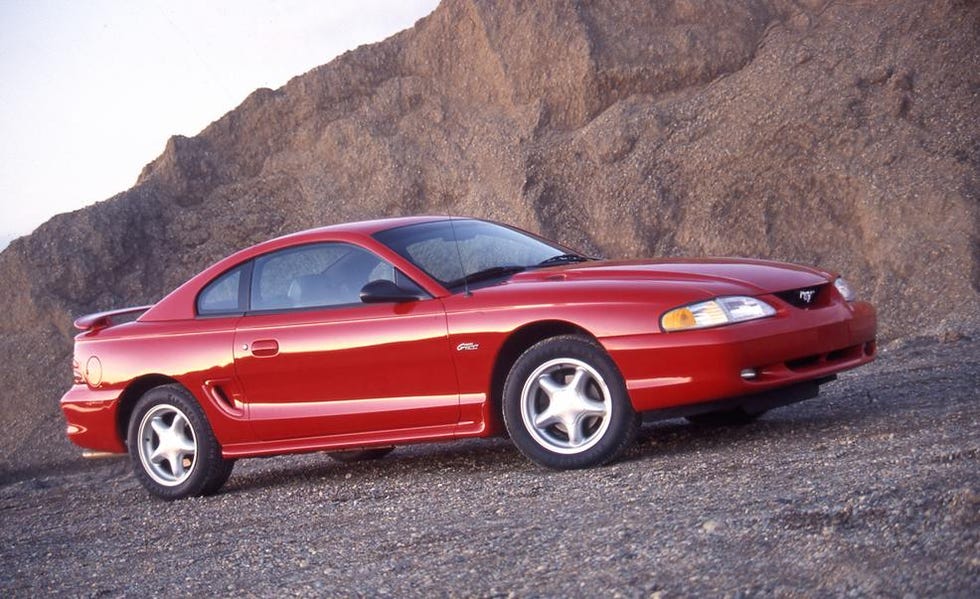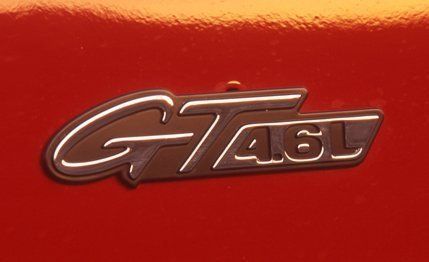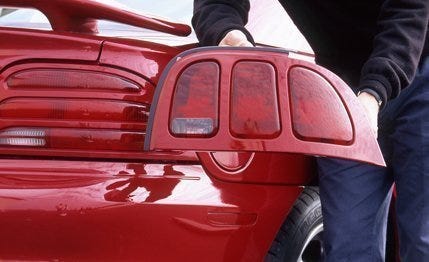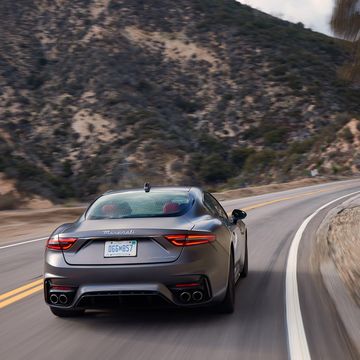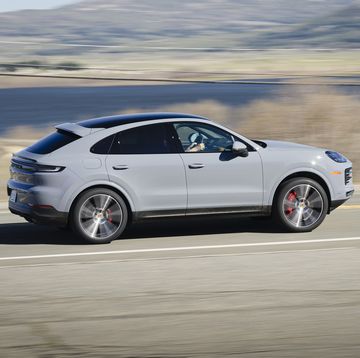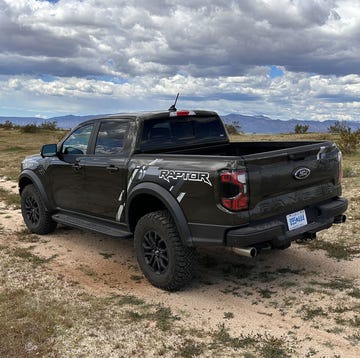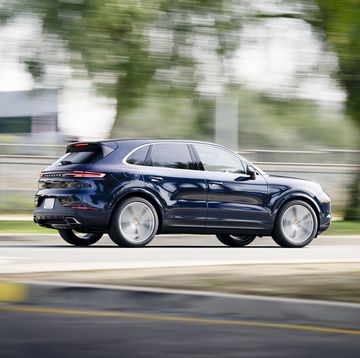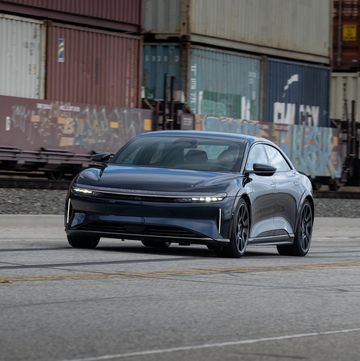From the September 1995 Issue of Car and Driver.
Now that the year-old redesign of the Ford Mustang has some miles on it, both Ford and the Mustang's obsessed clientele are ready for a few important changes. A Mustang Cobra making more than 300 hp is certainly welcome (see sidebar). And finally banished from the '96 Mustang GT is the ancient overhead-valve 4.9-liter V-8, which—in various guises—has powered Mustangs since their inception. Certain purists may wail and gnash their teeth over this one, but it's a transition we like.
The new engine for the GT, an SOHC 4.6-liter V-8, invokes technology that the obsolete 4.9er didn't have, yet it arrives at almost identical output. The main reasons for changing the engines were the tougher federal fuel-economy standards and onboard diagnostic system (OBD-II) requirements that both kick in for 1996. Ford knew the aged 4.9-liter was not going to make the cut anymore.
Most of the real improvements brought about by the mod V-8 powerplant are aimed not at performance, but rather at refinement. Noise, vibration, and harshness (NVH) characteristics are first addressed in the engine structure itself, with lightweight pistons and connecting rods, a deep-skirt block, deep head bolts, and five cross-bolted main bearings. The air-conditioning compressor, power-steering pump, and alternator are mounted directly to the engine to reduce their vibrations.
The new engine has a single overhead cam atop each cylinder bank to oversee the operation of two valves per cylinder. Ford's EEC-V electronic engine-management system controls the delivery of unleaded regular fuel through sequential multiport fuel injectors. Rather remarkably, the output derived from the engine is spot-on that of the GT's old motor. The 4.6-liter produces 215 horsepower at 4400 rpm and 285 pound-feet of grunt at 3500 against the 4.9-liter's 215 hp at 4200 and 285 pound-feet at 3400. Impressively, 250 pound-feet of torque is already online by 1500 rpm.
Rowing through the Borg-Warner T-45 five-speed manual (same as found in the Cobra companion model) is an easier task than with the T-5 it replaces. The clutch action is light without being weenie-grade, and the shifts are more precise although not quite perfect, because there's still more length in the throw than we like.
For those who prefer the shiftless route, the car will be offered with a new wide-ratio electronically controlled four-speed automatic transmission. Its torque converter was downsized from 12 inches to 11.25 inches, Ford said, in an effort to match the mod V-8's torque characteristics.
While hauling through the manual at wide-open throttle, though, we found the OHC engine breathes only a little bit better than the OHV motor. Both tend to breathlessness at about 5000 rpm; the 4.9-liter is breathless there, but the 4.6-liter is just beginning to reach for the Primatene. The new eight will soldier on through 5500 to 5700 rpm before the sustained revving starts to sound and feel like a bad idea. Shifting there is what the car seems to like for best times, but "best times" is a relative term.
Though it was entertaining enough in street driving, the new GT failed to impress in testing. Our '96 prototype test car was a virtually negligible 48 pounds lighter than the last 4.9-liter GT we tested, so we were surprised to find the new car slower—and less grippy as well. Our 0-to-60 runs in the '96 GT maxed out at 6.6 seconds, and the quarter-mile lasted 15.1 seconds at 92 mph. The previous-model GT ran 6.1 seconds to 60 and 14.9 seconds at 93 mph in the quarter.
The new GT notched only 0.81 g on the skidpad, against the old car's 0.85 g. This part was easy to diagnose—our '96 tester was shod with standard-equipment 225/55ZR-16 Firestone Firehawk SVX rubber. The previous GT test car rode on the optional larger 245/45ZR-17 Goodyear Eagle ZR45s. Ford still offers the bigger tires as an option on the car in '96. They're worth considering.
The handling is somewhat improved. Ford needed a new front crossmember to adapt the OHC eight to the Mustang. While they were at it, the suspension engineers jiggered the geometry for better caster and camber. A cross-car brace under the hood triangulates the strut towers and the firewall, abetting an already rigid structure, and a bigger rear anti-roll bar adds balance. Compared with the OHV GT, this brings improved steering precision and dry-surface handling but only marginal improvement in wet-surface control.
The new GT feels well balanced on hard sweepers at combat speed. Bump-steer mars the experience, but on smooth surfaces you can get fully into or out of the gas without materially unsettling the car. Drop-throttle oversteer lurks in the fastest or hardest corners, but inherent balance and an improved rack-and-pinion steering set makes recovery easy and trauma-free.
Anti-lock brakes are still optional, and dual airbags are still standard. In fact, nothing that you can see without opening the hood or crawling under the car is changed on the GT except a new fender badge incorporating the 4.6-liter engine designator.
Despite the improvements, the '96 Mustang GT still fails to stand up to the Z28 challenge, but you could say that unenviable job is now the duty of the 305-hp Cobra. That leaves the Mustang GT a domestic niche of its own, bracketed in between the entry-level V-6—powered Mustang/Camaro on the low end and the Cobra/Z28 powerhouses on the high end. Of course, that high end will get even higher in 1996 for the GM pony cars as well, with a dual exhaust system giving all V-8 Camaros and Firebirds another 10 hp (to 285) and Ram Air options boosting output to equal the Cobra's 305 hp.
After taking its share of beatings on the cubic-inch and power fronts, if not in the sales wars, glad the GT must be to have a new Cobra big brother to help shoulder the burden of its family feud. There's still one little problem looming on the horizon: the GT is the Mustang that is going to slot closest in price to the formidable Camaro Z28. The $19,500 estimated base price Ford gives us for the Mustang GT is, in fact, a few hundred dollars more than the Z28's $19,195 base price for '96. Is that going to be an ouch! for Ford, or what?

